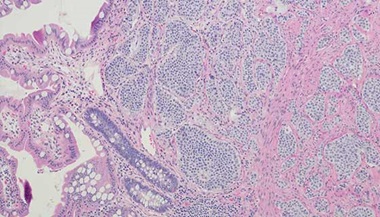Rectal Cancer Treatment
Before developing an individualized plan for rectal cancer treatment, your health care team will determine the extent of the disease using a variety of tests, which may include magnetic resonance imaging (MRI), endoscopic ultrasound, computed tomography (CT) and blood tests.
This evaluation is an important step in helping the team design the best and most effective treatment regimen. From these studies, we will be able to clinically stage your tumor. Treatment plans are then based upon the clinical stage of your tumor. These plans may include a single therapy or a combination of therapies. Treatment options include surgery, chemotherapy and radiation therapy.
For the most part, treatment for rectal cancer depends on the stage of the tumor—specifically the size and location of the tumor in the rectum as well as the degree of metastasis (how far the tumor may have spread).
Learn about treatment options for each of the following cancer stages:
In addition, biofeedback training in our cancer rehabilitation program may benefit rectal cancer patients before and after treatment.
Stage 0 Rectal Cancer Treatment
Rectal cancer that is confined to the inner lining of the rectum can typically be removed with minimally invasive surgery. Additional therapies are not usually needed.
Stage I Rectal Cancer Treatment
Stage I rectal cancer involves tumors that have grown into the wall of the rectum but are still localized (have not spread beyond the rectum). Most stage I rectal tumors are treated with surgery. When the location of the tumor allows for it, surgeons will try to avoid abdominal surgery by using minimally invasive techniques. The most common minimally invasive stage I surgical techniques include the following:
- Local transanal resection or excision: This procedure is used to remove early stage rectal cancers in the lower rectum. It is performed using instruments that are inserted through the rectum. In addition to removing the cancer from the rectal wall, the surgeon may remove some of the surrounding rectal tissue.
- Transanal endoscopic surgery: This procedure is used to remove larger cancers that may be located higher in the rectum and difficult to remove through local transanal resection. For this procedure, the surgeon inserts an endoscope through the anus and into the rectum to better visualize the tumor.
When stage I tumors can’t be removed through the rectum, it may be necessary to use more invasive surgical techniques, which are more common for stage II and stage III rectal cancers. These techniques include the following:
- Anterior resection: This technique is used for cancers in the upper rectum. The surgeon removes the part of the rectum containing the tumor and then reattaches the colon to the remaining part of the rectum. The incisions for this surgery are made through the abdomen.
- Low Anterior Resection: A Low Anterior Resection is used to treat cancers in the middle and lower rectum. During the procedure, the surgeon removes the entire rectum through abdominal incisions. The colon is then attached to the anus using a procedure called a coloanal anastomosis. During anastomosis surgery, the surgeon may create a small pouch in the colon to replace the rectum’s role in collecting fecal matter.
- Abdominoperineal resection (APR): This procedure is usually used to treat cancers in the lower rectum. The surgeon removes the rectum through abdominal incisions and removes the anus and sphincter muscles through incisions around the anus.
Your surgeon will discuss your surgical options with you, including possible sphincter-sparing techniques that could reduce your chances of needing a permanent colostomy.
Stage II and Stage III Rectal Cancer Treatment
Stage II rectal cancer is cancer that has grown through the wall of the rectum and possibly into nearby tissues. However, there is no lymph node involvement.
Stage III rectal cancer is cancer that has spread to nearby lymph nodes.
Most stage II and III rectal cancers are treated with a combination of chemotherapy, radiation therapy and surgery. The specific order and timing of these treatments will vary among patients.
Radiation and/or Chemotherapy Before Surgery
Radiation therapy, alone or in combination with chemotherapy, is often recommended prior to surgery to decrease the size of the tumor and further decrease the need for a colostomy. Advanced imaging techniques allows surgeons to evaluate the size and depth of the tumor before surgery to determine which patients would benefit from presurgical treatment.
Chemotherapy can also be given first, which is followed by a combination of radiation and additional chemotherapy. Some of the main chemotherapy drugs, used alone or in combination, for treating rectal cancer include the following:
- Fluorouracil (5-FU)
- Leucovorin
- Oxaliplatin
- Capecitabine (Xeloda)
Radiation Dosing
Radiation treatments for rectal cancer may be delivered in small doses over five to six weeks of daily treatment, or they may be delivered in higher doses over a condensed period of five days. Patients can work with their rectal cancer team to determine the ideal radiation therapy.
For instance, a longer treatment time may offer more time for a tumor to shrink. This can be important for tumors near the anal sphincter, where a surgeon will want to remove as little tissue as possible to avoid the sphincter muscle and preserve natural bowel function. In other cases, the small intestine may be in the field of radiation for tumors that occur very high in the rectum and closer to the colon. Since the small intestine is very sensitive to radiation, an intense five-day course of treatment might not be the first choice for patients and their radiation oncology team.
Types of Radiation Treatment
The types of radiation treatments most commonly used for rectal cancer include the following:
- External beam radiation: This treatment delivers a beam of high-energy X-rays to a patient’s tumor from outside the body. The following two therapies help radiation oncologists focus the radiation only on the tumor itself while avoiding surrounding healthy tissue:
- Intensity-modulated radiation therapy (IMRT) delivers targeted doses of radiation in a pattern to match the shape of the tumor.
- Image-guided radiation therapy (IGRT) uses images taken before and during the radiation delivery to guide the treatment.
- Brachytherapy: Used less often than external beam radiation to treat rectal cancer, this targeted, high-dose therapy is delivered directly into or near the tumor.
- Intraoperative radiation therapy (IORT): During surgery, this treatment is delivered directly to the tumor site after the tumor has been removed. The treatment comes from a radioactive source fed through wires that are placed on the tumor. IORT may be used for a rectal tumor that has infiltrated muscles or bones in the pelvis. It may also be used when rectal cancer has returned after a tumor was previously treated by radiation or surgery.
Surgery
After completing neoadjuvant chemoradiation, you should expect to repeat many of the imaging studies you had before to determine the response of your tumor to therapy. You will meet with your surgeon and review the surgical plan. The surgical options are included below. There are some preliminary studies evaluating less surgery or no surgery at all in the response to your therapy has been good. Your surgeon will discuss these options in detail when you see your surgeon again.
Treatments Following Surgery
Folowing neoadjuvant chemoradiaion and surgery, patients will receive an additional 5 – 6 months of chemotherapy. These treatments help prevent the cancer from coming back or spreading to other surrounding tissue and organs.
Colostomy and Ileostomy
A colostomy is a procedure that brings the end of the colon through an opening in the abdominal wall, allowing fecal matter to be passed out of the body when the rectum has been removed.. An ileostomy is a stoma that is placed after the bowel continuity has been restored. In this procedure, theend of the small intestine si brought up through an abdominal opening allowing the fecal stream to exit the intestines into a ostomy pouch instead of through the anus, giving this area time to heal. .
For some surgical procedures that remove all or part of the rectum, patients may need a temporary ileostomy while the rectal area heals. Patients who have the anus and surrounding sphincter muscle removed (e.g., during an abdominoperineal resection) will need a permanent colostomy. Whether your ostomy is permanent or temporary, your health care team will show you how to manage and care for your ostomy.
Stage IV Rectal Cancer Treatment
Rectal cancer that has spread beyond the rectum to distant organs and tissues is called stage IV or metastatic rectal cancer. Treatment for this stage may requires a combination of therapies to cure of limit the cancer growth including chemotherapy, radiation therapy and surgery. Chemotherapy is usually the first treatment choice in order to obtain control of disease spread. Other therapies including radiation and surgery may also be required depending on the location of the disease. Please refer to the above pages for types of other therapies used.
Chemotherapy
Patients with stage IV rectal cancer are likely to receive chemotherapy for their primary and metastatic cancers—both before and after surgery. The main chemotherapy drugs, used alone or in combination, for treating stage IV rectal cancer include the following:
- Fluorouracil (5-FU)
- Leucovorin
- Oxaliplatin
- Capecitabine (Xeloda)
- Irinotecan
- Bevacizumab (Avastin)
- Cetuximab (Erbitux)
- Panitumumab (Vectibix)
- Regorafenib (Stivarga)
- TAS-102 (Lonsurf)
Unresectable (Inoperable) Metastatic Rectal Cancer
If the cancer cannot be fully removed with surgery, your oncologist may instead recommend drug therapy that includes chemotherapy, targeted therapy and/or immunotherapy. If these drugs can shrink the tumors enough to make them operable, surgery may become a possibility.
When surgery isn’t an option, symptoms may be managed using the following techniques:
- Surgical or laser removal of the rectal tumor
- Cryotherapy
- Elective colostomy to bypass the tumor
- Rectal stent
- Chemotherapy
- Radiation
Recurrent Rectal Cancer Treatment
If rectal cancer returns after it has already been treated, treating it again can be both complicated and difficult. The cancer may return to the same location where it was initially treated, or it may return as metastatic cancer in distant organs like the liver or lungs. Patients should seek care from a colon cancer center with experience managing this complicated disease.
Localized Recurrent Cancer
Localized recurrent rectal cancer is treated with surgery. However, it can be more complex than the initial operation and require intraoperative radiation therapy (given during surgery). Chemotherapy and radiation therapy may also be given after surgery depending on what was used during the initial treatment.
Distant Recurrent Cancer
Distant recurrent rectal cancer is treated with surgery, if possible, as well as pre- and post-surgical chemotherapy. If tumors are inoperable, drug therapy, including chemotherapy and/or targeted therapy, may be used.
Biofeedback Cancer Rehabilitation Therapy for Rectal Cancer
Before and after treatment, patients can benefit from physical therapy that focuses on the muscle near the rectum knows as the levator muscles (pelvic floor).
It is important for rectal cancer patients to find a physical therapist who is trained to treat the pelvic floor (including bowel continence issues) and has experience providing pelvic floor therapy to cancer patients.
Biofeedback Cancer Rehabilitation therapy for rectal cancer consists of training the external and internal muscles of the pelvic floor that may be affected by surgery or radiation. Surgery may remove or weaken key muscles used in digestion and bowel movements. Radiation may shorten muscle fibers in the pelvic floor. These effects of radiation can last up to five to ten years after treatment.
Benefits of Biofeedback Cancer Rehabilitation
Biofeedback physical therapy can help improve the following:
- Urinary continence
- Constipation
- Clustering (having a bowel movement three to seven times in a row)
- Sexual dysfunction, including problems getting and maintaining an erection, vaginal dryness or tightness from radiation and pain during intercourse (Problems may occur for the first time after rectal cancer treatment, or treatment may exacerbate previous sexual dysfunction.)
Types of Biofeedback Cancer Rehabilitation Therapy
Biofeedback physical therapy includes the following:
- Clinic visits: During these visits, the physical therapist manipulates the pelvic muscles to help them work together in a coordinated way after treatment. Biofeedback (training to turn muscle action on and off) may be a significant part of this therapy.
- At-home exercises: These may include Kegel muscle exercises, deep breathing techniques and relaxation exercises. They can help patients gain control over urinary function and bowel movements.
When Therapy Is Used
If possible, rectal cancer patients should get physical therapy before treatment to ensure that the pelvic floor is in the best possible shape. Patients with a temporary ostomy should receive pelvic floor therapy while their ostomy is in place. This helps prepare the muscles to function properly when the ostomy is discontinued and bowel movements resume through the anus. Following rectal cancer treatment, biofeedback physical therapy usually begins with therapy sessions occurring once or twice weekly and gradually decreases to fewer treatment sessions over the course of three to six months.
Patient Perspectives | Gary Waymire – Colorectal Cancer
After a large polyp was discovered during a routine colonoscopy, Gary sought a second opinion at The Johns Hopkins Hospital. Treated with a series of aggressive and innovative procedures, he's now cancer-free and able to make the most out of life’s simple pleasures.







